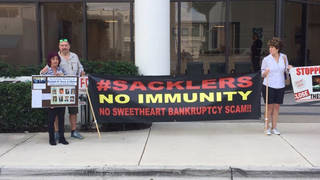
Topics
Guests
- Jan Hoffmanreporter for The New York Times who is covering the landmark opioid trial in Oklahoma.
For the first time, a pharmaceutical company is on trial for its role in the opioid crisis in Oklahoma this week. Johnson & Johnson—the corporate giant better known for its baby products—produces a fentanyl patch and previously also manufactured an opioid pill. In opening statements Tuesday, lawyers made a sweeping case against the company, accusing it of driving demand for opioids while the drug ravaged Oklahoma. The state says Johnson & Johnson targeted children and veterans to sell opioids. In court filings, Attorney General Mike Hunter likened Johnson & Johnson to a “kingpin” that has been targeting an unsuspecting public since the 1990s. Purdue Pharma settled with Oklahoma in March for $270 million, and Teva Pharmaceuticals reached an $85 million settlement deal Sunday, just ahead of the landmark trial. This leaves Johnson & Johnson as the only defendant in the first civil trial of its kind. The trial is expected to last two months, and will set the stage for the nearly 1,900 federal and state lawsuits targeting drug makers and distributors pending around the country. We speak with Jan Hoffman, a reporter for The New York Times who is covering the landmark opioid trial in Oklahoma.
Transcript
AMY GOODMAN: “Anything You Can Do (I Can Do Better)” from the Broadway musical Annie Get Your Gun. A lawyer representing the state of Oklahoma quoted this song in the landmark trial accusing Johnson & Johnson of fueling the opioid crisis. He said the company competed with Purdue Pharma using aggressive marketing. This is Democracy Now! I’m Amy Goodman, with Nermeen Shaikh.
NERMEEN SHAIKH: Well, we turn now to Oklahoma, where for the first time a pharmaceutical company is on trial for its role in the opioid crisis. Johnson & Johnson, the corporate giant better known for its baby products, produces a fentanyl patch and previously also manufactured an opioid pill.
In opening statements Tuesday, lawyers made a sweeping case against the company, accusing it of driving demand for opioids while the drug ravaged the state of Oklahoma. The state says Johnson & Johnson targeted children and veterans to sell opioids. In court filings, Attorney General Mike Hunter likened Johnson & Johnson to a “kingpin” that’s been targeting an unsuspecting public since the 1990s. This is Hunter speaking at the trial Tuesday.
ATTORNEY GENERAL MIKE HUNTER: The pain, anguish and heartbreak that Oklahoma families, businesses, communities and individual Oklahomans is almost impossible to comprehend. How did this happen? At the end of the day, Your Honor, I have a short, one-word answer: greed.
Decades ago, the defendants and their corporate collaborators rushed to fill the need the medical community created to address the fifth vital sign. Our evidence will show, Your Honor, that in their zeal to provide a magic drug, they ignored centuries of experience, well-documented scientific histories of deadly addiction epidemics, and embarked on a cynical, deceitful, multimillion-dollar brainwashing campaign to establish opioid analgesics as the magic drug.
AMY GOODMAN: Purdue Pharma settled with Oklahoma in March for $270 million, and Teva Pharmaceuticals reached an $85 million settlement deal on Sunday, just ahead of the landmark trial. This leaves Johnson & Johnson as the only defendant in the first civil trial of its kind. The trial is expected to last two months, will set the stage for nearly 1,900 federal and state lawsuits targeting drug makers and distributors pending around the country.
Well, for more, we go to Jan Hoffman, a reporter for The New York Times covering the landmark opioid trial.
Welcome to Democracy Now!, Jan. Talk about the significance of this trial in Oklahoma and why specifically we’re talking not Purdue Pharma, but Johnson & Johnson.
JAN HOFFMAN: This is the first trial of many that are really on the nationwide runway. Everyone is watching to see what formerly sealed and redacted documents will now come into the public that will tell a much broader and deeper story than the one we’ve known about already. Everyone is watching to see how certain legal arguments will play and to see what the pushback from one of the biggest manufacturers in the world—not necessarily of opioids, by the way—Johnson & Johnson, will use as a defense. This will affect not only the forthcoming federal trial slated for October 21st in Cleveland, Ohio—ironically, this is taking place in Cleveland County, Oklahoma—but will also very much affect settlement discussions that are ongoing at the state level and the federal level. Everyone is going to be watching Oklahoma to see: How is this going to play out? Will this tip my hand at the table, or will it not?
NERMEEN SHAIKH: Well, you know, Teva Pharmaceuticals settled with Oklahoma, but the company actually said in a statement, quote, “The settlement does not establish any wrongdoing on the part of the company; Teva has not contributed to the abuse of opioids in Oklahoma in any way,” they said, Teva Pharmaceuticals. So, could you talk about that, the fact that both Purdue and Teva have settled with Oklahoma? How is it that only Johnson & Johnson has not?
JAN HOFFMAN: Those are two separate questions. Actually, they’re three. Why did Purdue—really. Why did Purdue settle? Why did Teva settle? And why is Johnson & Johnson still on trial?
Purdue settled—and some have criticized that settlement as chump change. Purdue settled because they had a terrific winning hand. They had the threat—and still do—of bankruptcy. Oklahoma had a very difficult decision to make. Could they take Purdue to trial, possibly get a big settlement, have it be attacked in the appellate courts, and then have a bankruptcy judge turn to Oklahoma and say, “I’m sorry. We are protecting Oklahoma—I mean, we are protecting Purdue right now from any claims,” and therefore Oklahoma would get nothing? Or they could say, “Let’s settle this now, take what we can get, and call it a day.” So, I think that was very much the thinking behind Oklahoma, and certainly behind Purdue, as they settled this case. One of the big challenges for Purdue is to let it be known that this case is singular. They don’t want it to be set as a precedent for what else they will be paying in other cases. That’s a very tricky position for Purdue.
Teva is different. Teva makes generics. The question is: Did Teva promote these generics? Did they promote them as opioids and make certain claims to them? Teva didn’t. It never promoted, as far as it says, the drugs. So, the case is—the state’s case against Teva was, frankly, weaker. Teva, which is also an enormous corporation, also got out for chump change. Remember, they paid less than half of what Purdue paid.
This leaves Johnson & Johnson, whose, I think, 2017 or '18 sales were $81.6 billion worldwide. So Johnson & Johnson has the deepest pockets of all the three defendants so far. Johnson & Johnson is known as being a company that likes to go to trial—I mean, well, nobody likes to go to trial. But when they're accused of something, they will fight, particularly if they feel they have a strong case. J&J is worried about setting precedent, worried about, you know, showing that they could lose at trial—frankly, they’re worried about losing at the appellate courts, because whether they’re going to prevail before a state court judge is—you figure that one out. So they basically said, “Let’s show them our hand. Let’s show them our defense. Let’s fight this case. Let’s bring it through the courts. We’ll lose, frankly, in terms of damage to our reputation, but in the long run we may win, further down the road.”
AMY GOODMAN: Oklahoma Attorney General Mike Hunter says, over a three-year period, from 2015 to 2018, that there were 18 million prescriptions for opioids written in Oklahoma, which has a population of just under 4 million.
JAN HOFFMAN: Correct.
AMY GOODMAN: Eighteen million prescriptions for 4 million. Also, over 15 years, overdose deaths increased by 91%. These are extraordinary figures. And you have Johnson & Johnson lawyers saying, “Well, these drugs have FDA approval.” Can you respond to both?
JAN HOFFMAN: Sure. Really, this is why the J&J lawyer—and, believe me, I don’t want to be seen as carrying water for J&J, but the J&J lawyer said—and this will be the sort of crux of their defense—facts are stubborn things. When you start to drill down into that data, you see that you are not particularizing those overdose deaths from one drug to another. Are they from heroin? Are they from fentanyl? Are they from fentanyl from China? Are they from heroin from across the border? Are they from pill mills that were shut down because they were either illegal or criminal? We don’t know. That’s the problem in terms of establishing liability to J&J. There’s no question that the country has been staggered by the opioid crisis or the opioid emergency. But the real legal question is: How do you apportion blame fairly? And that is a very high legal hurdle.
AMY GOODMAN: You—
JAN HOFFMAN: Because in between—let me just say, briefly—and one of the things Oklahoma is missing, that other cases have, is other cases have charged not only the manufacturers, but they’ve charged the distributors, who had—who were the direct salespeople to the pharmacies and did have an obligation to report to the DEA how many pills they were delivering to these pharmacies, that were out of bounds. They had named pharmacy chains, like CVS. They have named some individual doctors. So there are a lot of bad—well, purportedly bad actors in this long chain of causality.
NERMEEN SHAIKH: Well, Jan, could you talk about the broader impact of this opioid crisis? I mean, Oklahoma is largely a rural state, and it’s been completely ravaged by this crisis. Is it the case that most of the states in the U.S. that are most affected are also principally rural? And talk about your own reporting, specifically, about the opioid epidemic amongst the Cherokee Nation.
JAN HOFFMAN: It’s true that—I’ll bifurcate that. It’s true that certainly rural areas have been terribly hard hit, but you go to the Bronx, and you will see how the opioid crisis has devastated the Bronx. It has gone from pills to heroin and fentanyl. So there’s a trajectory there that has really hit urban areas as powerfully as it has rural areas, although it certainly began in rural areas. I mean, I spent a fairly long time in the ER in a hospital in Paterson, New Jersey, which was just assaulted with opioid overdoses. And New Jersey has been pummeled by this crisis—thank you, Johnson & Johnson, which happens to be a New Jersey-based company. Again, I shouldn’t have said that. We don’t know yet to what degree Johnson & Johnson has liability for this.
I went separately to the Cherokee Nation because they, among all the tribes in the United States, chose to bring their own case against this cluster of manufacturers, distributors and pharmacies in tribal court. This was a novel and bold legal approach. And I wanted to see why they chose to take it to tribal court rather than join the state of Oklahoma or even join the federal litigation. And certainly, the Cherokee Nation is arguably even harder hit than Oklahoma as a state has been. They certainly had cause to want to bring justice to their people in their own courts. Ultimately, they didn’t prevail in keeping the case in tribal court.
AMY GOODMAN: Jan Hoffman, I want to thank you so much for being with us. Of course, we’re going to continue to cover this landmark trial. Jan Hoffman, a reporter for The New York Times covering the opioid trial underway in Oklahoma.
When we come back in 20 seconds, we look at, well, what’s happened to that plan for Harriet Tubman to replace Andrew Jackson on the $20 bill. Stay with us.













Media Options